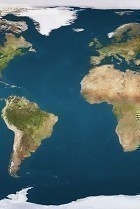Global warming 'pause' due to unusual trade winds in Pacific ocean, study finds

The contentious "pause" in global warming over the past decade is largely due to unusually strong trade winds in the Pacific ocean that have buried surface heat deep underwater, new research has found.
A joint Australian and US study analysed why the rise in the Earth's global average surface temperature has slowed since 2001, after rapidly increasing from the 1970s.
The research shows that sharply accelerating trade winds in central and eastern areas of the Pacific have driven warm surface water to the ocean's depths, reducing the amount of heat that flows into the atmosphere.
In turn, the lowering of sea surface temperatures in the Pacific triggers further cooling in other regions.
The study, which is published in the journal Nature Climate Change, calculated the net cooling effect on global average surface temperatures as between 0.1C and 0.2C (0.2-0.4F), accounting for much of the hiatus in surface warming. The study's authors said there has been a 0.2C gap between models used to predict warming and actual observed warming since 2001.
The findings should provide fresh certainty about the reasons behind the warming hiatus, which has been claimed by critics of mainstream climate science as evidence that the models are flawed and predictions of rising temperatures have been exaggerated.
The UN's Intergovernmental Panel on Climate Change (IPCC) addressed the warming pause issue in its 2013 climate report, pointing out that the Earth is going through a solar minimum and that more than 90% of the world's extra heat is being soaked up by the oceans, rather than lingering on the surface.
Matthew England, a climate scientist at the University of New South Wales in Sydney, and leader of the research, said that while the solar minimum and aerosol particles have contributed to the slowdown, strong trade winds are the significant factor.
"Temperature models have an envelope of uncertainty but it is clear that the last decade has seen a much flatter temperature change compared to the 1980s and 1990s, when the increase was rapid," he said.
"We found that the wind acceleration has been strong enough in the past 20 years to pump a lot of the heat into the ocean. Winds accelerated in this period more than at any time in the past century; it really is unprecedented and the models haven't captured it all."
The acceleration of Pacific trade winds has been twice as strong in the past 20 years compared with the prior 80 years, cooling the east Pacific and propagating the trend to other parts of the world.
The study suggests the warming hiatus could continue for much of the present decade if the trade winds continue; however, should the winds return to their long-term average speeds, rapid warming will resume.

"Even if the winds accelerate even further, sooner or later the impact of greenhouse gases will overwhelm the effect," England said. "And if the winds relax, the heat will come out quickly. As we go through the 21st century, we are less and less likely to have a cooler decade. Greenhouse gases will certainly win out in the end."
England said it was unclear what has caused the increase in Pacific trade winds, although warming in the Indian Ocean has been cited as a potential trigger.
Dr Steve Rintoul, research team leader at CSIRO Marine and Atmospheric Research, said the research shows that pauses in the rate of global warming are to be expected.
"The oceans have continued to warm unabated, even during the recent hiatus in warming of surface temperature," he said.
"Natural variations of the climate system also mean that climate trends estimated over a short period are unlikely to reflect long-term changes. A decade or two of slower or faster warming does not tell us anything about long-term climate change."
Richard Allan, professor of climate science at the University of Reading, said it is likely the current warming slowdown is only a temporary reprieve from brisk increases in global temperatures.
"This new research suggests that when the trade winds weaken again, the planet can expect rapid warming of the surface to resume, as greenhouse gas concentrations continue to rise," he said.
"We don't know what is causing these unprecedented changes, but the implications could be substantial."
• This article was amended on 10 February, 2014, to give the correct Celsius to Fahrenheit conversion for the calculation of the net cooling affect on global average surface temperatures
Original story by The Guardian via Google News
Satellite image from Wikimedia Commons, Ocean image from Flickr/Honza Soukup under Creative Commons License 2.0


Post your comment
You cannot post comments until you have logged in.
Login to post a commentComments
No one has commented on this page yet.
RSS feed for comments on this page | RSS feed for all comments